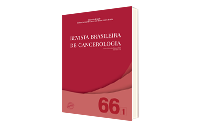Female Breast Cancer Mortality in Alagoas from 2001 to 2016: Trend Analysis and Spatial Distribution
DOI:
https://doi.org/10.32635/2176-9745.RBC.2020v66n1.656Keywords:
Breast Neoplasms/mortality, Breast Neoplasms/epidemiology, DemographyAbstract
Introduction: Breast cancer is the neoplasm that causes more deaths in the female population worldwide and in Brazil. Objective: To analyze the epidemiological profile, trend and spatial distribution of female breast cancer mortality in Alagoas from 2001 to 2016. Method: Mixed ecological study, including female deaths from breast cancer recorded in Alagoas in the period. Sociodemographic variables (age, color/race, marital status, education and place of occurrence) and the specific mortality rate by age group and municipality were used. Data were obtained from the Mortality Information System and population data from the Brazilian Institute of Geography and Statistics (IBGE). The trend analysis used the Joinpoint regression model and Moran statistics for the spatial distribution. Results: 1,816 deaths in the period, 25.3% between 50-59 years, 46.3%, brown race, 36.1%, married, 35.5%, with less than 8 years of education and 67.2% of deaths within the hospital environment. The age groups of 40 years or older showed a growing trend and the highest growth, for 80 years old or more (average annual percent variation: 9.2; p<0.001). The spatial distribution was random. Conclusion: The mortality rate for female breast cancer increased in the period from 2001 to 2016 in the age group of 40 years and older in the state and without defined spatial pattern.









